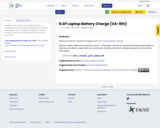
Directions: Put each decimal in the category in which it belongs by rounding to the nearest whole number. Does it ROUND to 49, or 50??
- Subject:
- Mathematics
- Material Type:
- Activity/Lab
- Author:
- Shamika Carey
- Date Added:
- 11/09/2022

Directions: Put each decimal in the category in which it belongs by rounding to the nearest whole number. Does it ROUND to 49, or 50??

Directions: Students will practice the least common multiple of two numbers.

Slope Discovery Power Point Activity by C. Hogan
Virginia Department of Education resource titled, "Slope Discovery," which is an activity resource in which the student will determine slope, write the equation in slope-intercept form, and graph a line.

This final project uses the 52 Minute Challenge to allow students a chance to pitch a real idea to create a more environmentally friendly school.
A remix of https://goopenva.org/courses/52-minute-challenge.

This final project uses the 52 Minute Challenge to allow students a chance to pitch a real idea to create a more environmentally friendly school.
A remix of https://goopenva.org/courses/52-minute-challenge.

This final project uses the 52 Minute Challenge to allow students a chance to pitch a real idea to create a more environmentally friendly school.
A remix of https://goopenva.org/courses/52-minute-challenge.

Directions: Drag each number to a star ordering from least to greatest or greatest to least.

Directions: Drag the sum or difference in the box. Make sure the sum or difference is in simplest form! Use the fraction tile virtual manipulatives if you need to.

This PDF information sheet covers the 5 types of basic computer networks with review questions.Strand: Networking and the InterentSOL(s): 5.17 The student will compare and contrast the difference between a local network and a worldwide network.

The opening slide describes that the best deal is getting more for your money. Things on sale are not always at the best price and the amount of product matters. Students are given five slides with two or three prices. Students have to determine which is a better deal. Students may use unit rates, but students are also asked to use another way to determine which is a better deal. Students can scale up or down using ratio tables or by purchasing the same quantity of each item.

This lesson should be used as practice after students have had experience with ratio tables, graphing points, and determining proportional relationships. On slides 1-4 students are given a situation, then they complete the ratio table, graph the coordinates, and determine if the relationship is proportional. On slides 5-7 students are given graphs and asked to determine if it represents proportional relationships, and explain why. On slide 8 students are given written situations and asked to determine if they represent proportional relationships and explain their reasoning. This lesson was created with Jamboard to provide teachers and students with real time collaboration.

Directions: Solve the following inequalities. Write each with the variable on the left and then on the right. Graph it on the number line. Label 3 points on the number line. Tell 3 numbers that would be in the solution set and if the circle is open or closed.

The student will complete a task where they are given 50 feet of fencing. They have to design the largest area of garden using all of the fencing. Students must explore circles, right triangles, and rectangles. Students will be using the formulas of area and perimeter and circumference to calculate perimeter and area. This task was created with Jamboard to allow students to collaborate together in person or remotely, in real time, as well as allowing the teacher to view students' work in progress. The initial slide presents the task and provides the formulas for each shape’s area and perimeter. The subsequent slides provide workspace for students’ thinking and collaboration. The last slide is a conclusion slide. Here students tell which shape they chose, give the measurements, and justification

With this activity, students will review the components of the coordinate plane, graph coordinates, and tell coordinates. This activity was created with Jamboard to allow the teacher to view students placements of points and work in real time. The activity can be presented to the whole group with the teacher giving students assignments on each slide (by sharing editor rights) or assigned to individual students with each a copy.

Encourage your students to creatively explore character building through practicing the 8 Efforts of Laban!

Students view a screenshot of different times throughout the day and remaining cell phone battery percentages. After creating a scatterplot to display the data, students can make inferences and draw conclusions.

Can you see how far you can catapult a Pom Pom? I want to see! We are going to be building a catapult from scratch. Your goal is to see if you can catapult your Pom Pom at least 3 feet.

How many food chains are there within this ecosystem? Let’s create some to find out! You will have 5 minutes to create as many food chains as you can with your partner. Please record your food chains on a sheet of paper as you go.

Want to learn about how to describe matter and sort as well as learn about impacts of computing at the kindergarten level? If so, this fun and easy lesson is for you!

This resource is a comprehensive unit of instruction created and piloted by the ACSE Region III team over the 2022-23 school year. This unit, which is accessible through multiple links to include worksheets, slidedecks, teacher suggestions and planning documents, includes all components of the instruction with SOL connections and is intended to join Computer Science standards to an ELA content area.